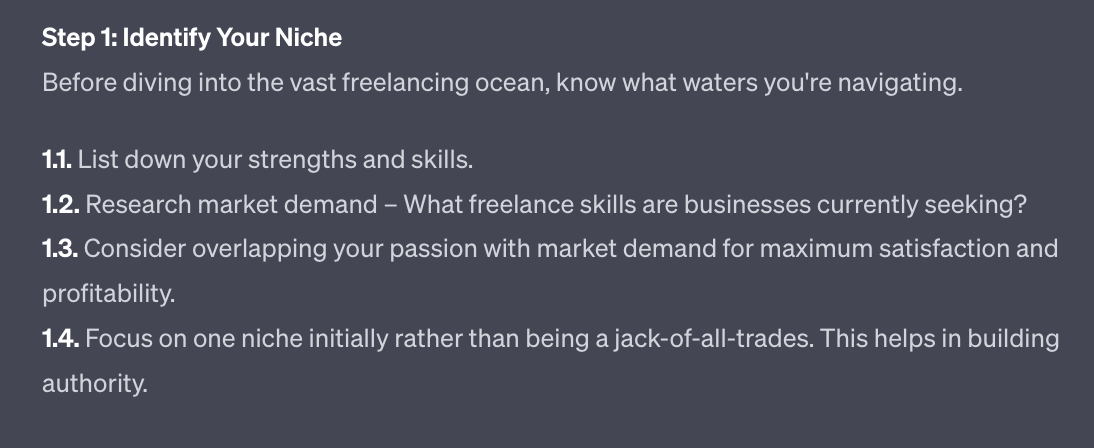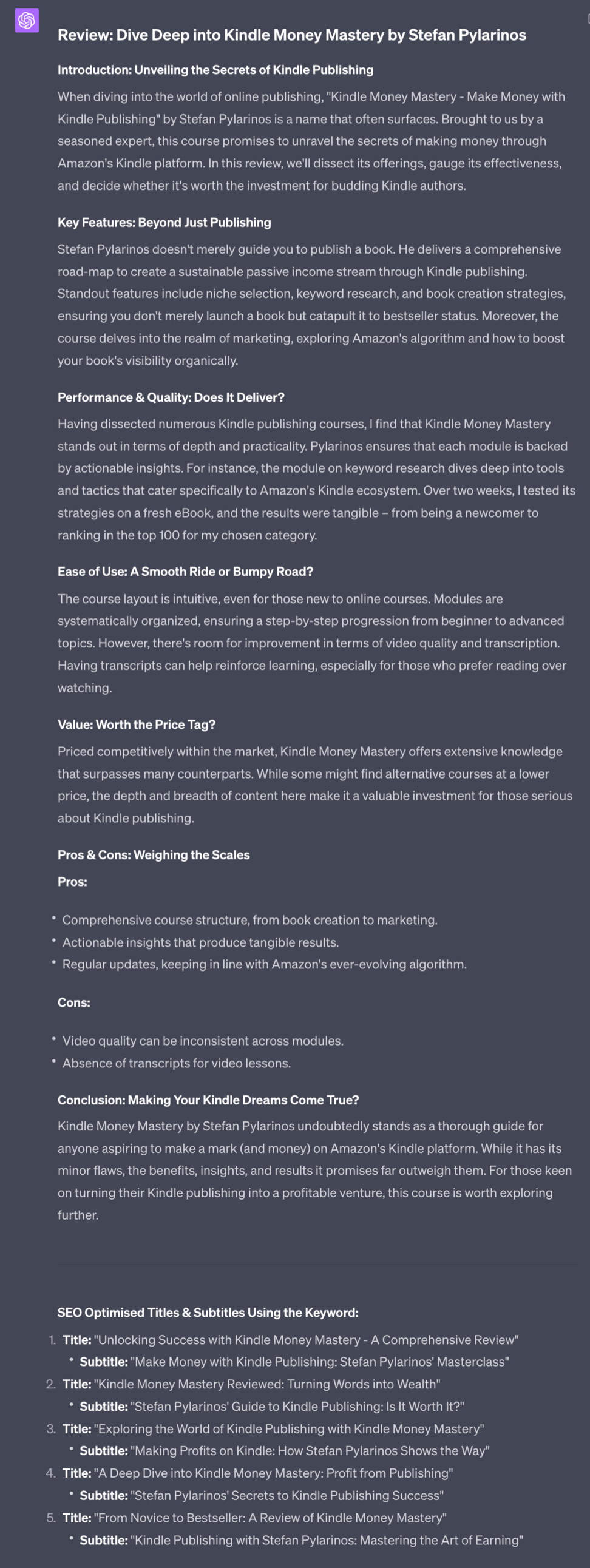Hey Prompt Entrepreneur,
In the last Part we had a look at three types of long-form content.
Each was designed to go into a subject (defined by a keyword) in depth.
Long form articles rank really well on Google because they allow us to include lots of information and also, when read, lead to longer on-page time.
However, for some content we should use shorter form content. Generally we want shorter form content to deal with a single point.
Our longer form content remember tended to deal with multiple ideas – for example a step by step guide with multiple steps or a list of business ideas. These posts have lots of information over multiple points.
Short form on the other hand should have one main point. This makes them easier to consume in one sitting and a perfect “entry point” into our content ecosystem.
You’ll be creating a mix of long form and short form content – we’ll cover the exact content mix in the final Part. For now let’s cover some short form content formats.
Let’s get started:
Short form content
1. Single question or point
Our first format is also the simplest.
This is where we want a short form piece to either:
- answer one question
- make one point
Looking at my list of keywords I might choose “what is an online business” as a keyword. This is a quick definition type piece where I don’t need 1000s of words to make the point.
In fact going into a long guide about what exactly an online business is is not helpful for the reader – they just want a quick answer!
Use this prompt:
Act as an SEO expert.
Write a short form blog article on keyword : [keyword]
Give me 5 SEO optimised titles and subtitles that use the keyword.
Use this structure
1. Introduction (100-150 words):
Hook - Intriguing fact/statistic
State the term being defined or question being answered
Explain importance or common misconceptions
Preview main points
2.Main Body (500-800 words):
2a Definition or Background (100-150 words)
Concise definition or context about the topic
Origins or history briefly
2b Key Details (100-200 words)
Main attributes, qualities, components, or examples
Use lists/bullets for clarity as needed
Common Confusion (100-150 words)
Address frequent questions or misconceptions
Provide straightforward answers
2c Relevance (100-150 words)
Discuss modern day usage, applications, or prevalence
Share relevant statistic or data
2d Tips or Best Practices (100-150 words)
Tips for properly applying the knowledge
Recommendations related to topic
3 Conclusion (50-100 words):
Summarize key points in 1-2 sentences
Final thought on significance or call to action
Write in an educational, highly readable tone. The goal is to move the reader from one sentence to the next easily.
Do not include the structuring guidelines. Instead provide SEO optimised subheaders throughout. Write in prose rather than all in bullet points.
The whole piece should be 500-1000 words
Give me the entire piece, do not ask me to expand. In the example below I use “what is online business” as the [keyword]. Enter your own keyword in the prompt.
Prompt Output 💬

Not bad! This is a solid length, focused on one specific topic. It gives some definitions, helps with common confusions and even gives some best practices. It’s a fine piece of work that you can use as a jumping off point for your final piece.
2. Expansion from Long Form
In the last Part I briefly mentioned this. Now it’s time to loop back.
Remember this image?

At the end of Step 1 (How-to Guide Format) I mentioned how when expanding out content you could actually create separate blog articles.
I mentioned how any of these sub-steps could actually be its own blog article.
Let’s close that loop!
For instance here I could write a whole blog article about “listing your strengths and skills”
I would then link this new article to the step 1.1 above. So anyone reading the long form guide could choose to come to the blog article about strengths and skills.
This creates an even deeper layer of content by building links between your long form and short form content. We call this “internal linking” – basically links between different parts of your website to help visitors find their way around.
We have two options here:
- Create the short form piece from scratch then link back up to the longer form post OR
- In the same chat as the long form piece generate the short form expansions.
The second option is easier. Make sure you are in the same chat window as the long form piece and use this prompt:
Act as an SEO expert.
Write a short form blog article on [portion of longer article]
Use the context of the main article.
Give me 5 SEO optimised titles and subtitles that use the keyword.
Use this structure
1. Introduction (100-150 words):
Hook - Intriguing fact/statistic
State the term being defined or question being answered
Explain importance or common misconceptions
Preview main points
2.Main Body (500-800 words):
2a Definition or Background (100-150 words)
Concise definition or context about the topic
Origins or history briefly
2b Key Details (100-200 words)
Main attributes, qualities, components, steps or examples
Use lists/bullets for clarity as needed
Common Confusion (100-150 words)
Address frequent questions or misconceptions
Provide straightforward answers
2c Relevance (100-150 words)
Discuss modern day usage, applications, or prevalence
Share relevant statistic or data
2d Tips or Best Practices (100-150 words)
Tips for properly applying the knowledge
Recommendations related to topic
3 Conclusion (50-100 words):
Summarize key points in 1-2 sentences
Final thought on significance or call to action
Write in an educational, highly readable tone. The goal is to move the reader from one sentence to the next easily.
Do not include the structuring guidelines. Instead provide SEO optimised subheaders throughout. Write in prose rather than all in bullet points.
The whole piece should be 500-1000 words
Give me the entire piece, do not ask me to expand. Put in the specific part of the longer article you want to expand into a separate post.
In this example I used “Step 1.1 List down your strengths and skills” .
Prompt Output 💬

This is just the first couple hundred words – ChatGPT will generate the whole piece for you.
Turn this into its own shorter blog article and then link from the longer piece to the new blog article to build valuable internal linking.
3. Reviews
Another perfect subject for a short form post are product and service reviews.
These are most relevant if you website focuses on other company’s products and services – for instance if you do affiliate marketing.
Act as an SEO expert.
Write a review post on [product/service]
Give me 5 SEO optimised titles and subtitles that use the keyword.
Use this structure
Introduction (100-150 words)
Name the product/service being reviewed
Brief background on product/service and company
Set expectations on what will be covered in review
Key Features (150-250 words)
Provide an overview of the main features and specifications
Highlight most notable or important capabilities
Performance & Quality (150-200 words)
Assess how well the key features deliver as advertised
Rate the overall quality and durability based on your experience
Provide examples testing different use cases
Ease of Use (100-150 words)
Evaluate the learning curve and intuitiveness
Share examples of workflows or tasks you accomplished
Note any friction points or areas for improvement
Value (50-100 words)
State the price/cost of product/service
Determine if it provides good value for money
Compare price to competitors or alternatives
Pros & Cons (150-200 words)
List 3-5 pros such as highlights, standouts, benefits
List 2-3 cons like frustrations, limitations, or downsides
Conclusion (50-100 words)
Summarize overall thoughts and recommend or not
Reiterate who would find it most useful
Share where to learn more or make a purchase
Write in an educational, highly readable tone. The goal is to move the reader from one sentence to the next easily.
Do not include the structuring guidelines. Instead provide SEO optimised subheaders throughout. Write in prose rather than all in bullet points.
The whole piece should be 500-1000 words
Give me the entire piece, do not ask me to expand. For this example I dropped in “Kindle Money Mastery – Make Money with Kindle Publishing Stefan Pylarinos” which is an online course in the “making money online” niche.
Prompt Output 💬

Ideally combine these review structures with your own experiences. The best reviews of course come from personal experience. If you do have experience with the product make sure to add these details into the prompt to create the best output.
Pulling it together
These three basic short formats will help supplement your long form content.
These three options allow you to create new content directly from your keyword list, from products/services you want to review and by expanding certain topics from other pieces into their own post.
As with long form content apply the most applicable format. This will depend on your niche so just experiment until you find fit.
In the next Part we’ll discuss your content plan, balancing out long form and short form content and how to continually optimise your SEO work.
A reminder of this week:
Part 1: What is SEO + Keyword Research
Part 2: SEO structure and setup
Part 3: Long form content
Part 4: Short form content
Part 5: SEO optimisation
